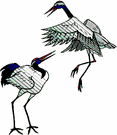In the August edition (yeah, I'm really staying on top of my reading) of the magazine
Birder's World, Pete Dunne wrote about the difference between "really watching" birds and "acquiring" them. By acquiring, he is discussing the desire by some birders to "get" more and more birds. Pete states, "Once they succeed in finding a bird, and their need to get is trumped by
have, they seem not to savor the achievement much."
Pete notes he is not anti-listing and notes that keeping track of the birds one has seen can be "a fund and satisfying facet of birding" (note he said "a" not the only way to enjoy birds). But his contention in this article is that birds are more than just a tick on a list. He focuses on the art (my word) of "really watching" birds, something he was fortunate enough to learn in childhood.
Pete Dunne says that "really watching" birds, or engaging them, is not only fun but educational. He states, "Wasn't until years later that I found out that I was doing it all wrong. All you have to do to be a birdwatcher is identify each species, then check it off a list."
I think most of us learn to be birders from listers. I know when I first started watching birds, I thought that all birders were listers and that the only facet of value in birding was identifying the species and checking it off my list and trying to acquire more birds on my list to prove how good I was at birding. And I made list after list after list. But something held me back from finally tabulating them all into a life list.
I eventually realized that I enjoyed engaging birds more than acquiring them on my lists. I should have known that all the bookwork in maintaining lists was not what I enjoy. I had tried coin-collecting in the past, but I found all that book work and worry about how rare the coin was did not sustain my interest. The same happened with a brief foray with stamp collecting. Though I still make lists of birds I have seen (usually limited to day or place lists), they are usually so I can report species or write about them. I do not maintain a life list. I rather spend the time either engaging the birds, sharing them like on this blog or learning more about them.

 Just two last pics of the Long-tailed Duck that remained on the Arkansas River near Canon City until today. The last I saw this duck was when some other diving ducks flushed and flew off. I looked for it twice this afternoon and it wasn't in the area.
Just two last pics of the Long-tailed Duck that remained on the Arkansas River near Canon City until today. The last I saw this duck was when some other diving ducks flushed and flew off. I looked for it twice this afternoon and it wasn't in the area. 



































